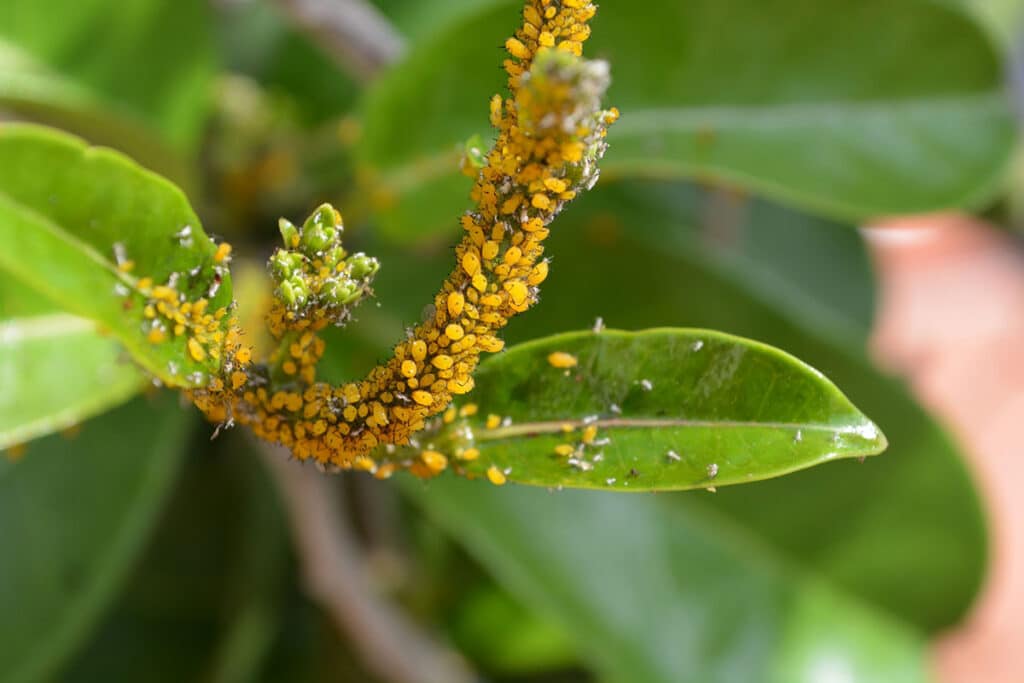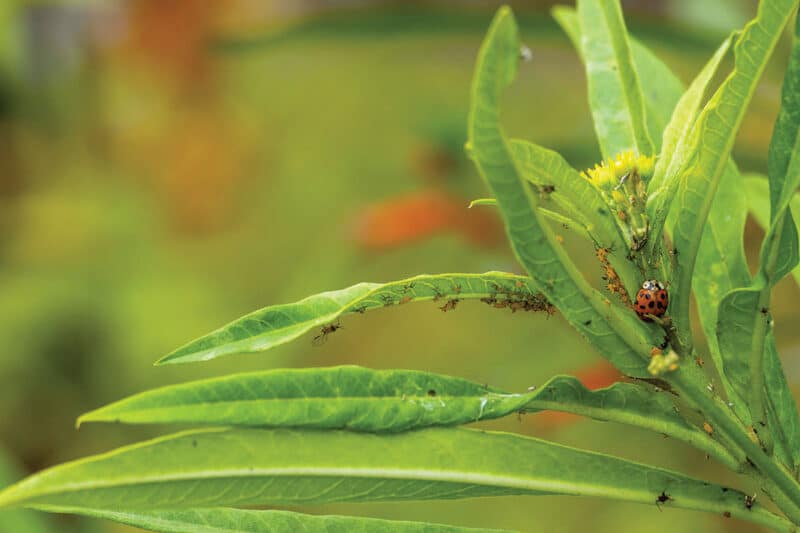by Dr. Sarah Treanor Bois, PhD
Director of Research & Education at the Linda Loring Nature Foundation
Aphids may be the bane of existence for some gardeners. However, these tiny sap-sucking insects are a diverse group with some pretty interesting habits. Aphids are very common insects and are found on many plants in yards and gardens. In most cases they cause little or no damage to the health of plants. There are more than 1,200 species in North America. While some are generalists, most species of aphids are monophagous or feed on just a few species of closely related plants. If
you have milkweed (any species) in your yard, you may notice some small, orange residents towards the top of the steps of milkweed. These are aphids causing ire to many trying to maintain milkweed populations in the name of monarch conservation.
Milkweed is named for the milky sap inside the plant. The sap is toxic to most insects and is a deterrent for herbivores. Many know the story of monarchs—that the caterpillars are one of the few insects that can digest milkweed leaves and sequester the toxin transferring the toxic defense mechanism to their bodies.
But this story is less about monarchs and more about the aphids. Aphids are another insect that has evolved the ability to access the nutrients within the milkweed plant without the effects of the toxicity. Aphids feed by directly tapping into the phloem of the plant stem sucking up the sugars.
There are lots of different species of aphids. On our milkweed plants, we have oleander aphids (sometimes called milkweed aphids). The tiny, orange aphids are non-native, most likely originating in the Mediterranean region where it’s principal host plant, oleander, grows.
The aphid’s ability to extract nutrients from the milkweed without the effect of the toxicity can be useful. Aphid poop from almost any plant is actually a hot commodity for other insects. Known as “honeydew” aphid excrement contains multiple sugars, but none of the toxicity for those feeding on milkweed. Who loves honeydew the most?
Well, ants are the best at cornering the market on honeydew. Many species of ants actually do this. It’s a symbiotic relationship benefitting both species. For the ants, they “farm” the aphids. People use the term “aphid farming” to reference the behavior of the ants. Ants will work together to pick up the aphids and put them together on a plant, corralling the aphids into one area. This way it’s easier for the ants to collect the honeydew and also to protect them.
So what do the aphids get out of this? They get protection. The ants are not eating the aphids, they are protecting them as a vital resource. The primary predator? Ladybugs. Lady bugs (or lady beetles) eat aphids, as many gardeners know. However, ants will gang up and attack ladybugs. There is evidence, too, that some ants will find and destroy ladybug eggs.
Some ants even go so far as to build small shelters for the aphids or to keep root-feeding aphids inside their own nests. A few species of aphids have become so dependent on their ants that they won’t even excrete honeydew unless stimulated by an ant!
Aphid-herding ants make sure aphids stay well-fed and safe. When the host plant is depleted of nutrients, the ants carry their aphids to a new food source. For some species of ants, they also bring the aphids back into their nests at night and for the winter. They use their antennae to “coax” the aphids into secreting the honeydew which the ants lap up. It’s been described like “milking a cow,” but really the ant caresses the aphid with it’s antennae to get the honeydew to come out.
It may not be all good for the aphids. Aphids are almost always wingless, but certain environmental conditions will trigger them to develop wings. If the aphid population becomes too dense, or food sources decline, aphids can grow wings to fly to a new location. Ants, however, do not look favorably upon losing their food source. In some instances, ants have been known to bite the wings off of aphids to keep them in line. A recent study also showed that some ants can use semiochemicals to stop the aphids from developing wings and to impede their ability to walk away.

Observing some of our milkweed around my office this week, we found lots of evidence of aphids on some, but not all, milkweed plants. We also found ants and ladybugs in the patch. We didn’t see the full drama play out, but all the characters were there. Our milkweed are healthy, though, with some tiny monarch caterpillars feasting away.
For those of you who don’t want to see all of the aphids and worry about plant damage, please don’t use insecticides. They are not species-specific and so will affect all the other insects you want to see in your garden. If the aphid populations become too dense, use your fingers to squish the aphids. Some people have described using forceful water to spray aphids off, however, for milkweed, I don’t recommend using high pressure water to remove the aphids as this could also remove any monarch caterpillars that are present on the plant.
Here is a video explaining the ant-aphid symbiosis with some pretty cool images: youtube.com/watch?v=frPQ0EUlIMY Or you can check out your own milkweed plants and see if you can find some aphid farming yourself.



